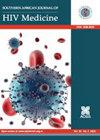Outcomes of patients enrolled in an antiretroviral adherence club with recent viral suppression after experiencing elevated viral loads
IF 1.6
4区 医学
Q4 INFECTIOUS DISEASES
引用次数: 10
Abstract
Background Eligibility for differentiated antiretroviral therapy (ART) delivery models has to date been limited to low-risk stable patients. Objectives We examined the outcomes of patients who accessed their care and treatment through an ART adherence club (AC), a differentiated ART delivery model, immediately following receiving support to achieve viral suppression after experiencing elevated viral loads (VLs) at a high-burden ART clinic in Khayelitsha, South Africa. Methods Beginning in February 2012, patients with VLs above 400 copies/mL either on first- or second-line regimens received a structured intervention developed for patients at risk of treatment failure. Patients who successfully suppressed either on the same regimen or after regimen switch were offered immediate enrolment in an AC facilitated by a lay community health worker. We conducted a retrospective cohort analysis of patients who enrolled in an AC directly after receiving suppression support. We analysed outcomes (retention in care, retention in AC care and viral rebound) using Kaplan–Meier methods with follow-up from October 2012 to June 2015. Results A total of 165 patients were enrolled in an AC following suppression (81.8% female, median age 36.2 years). At the closure of the study, 119 patients (72.0%) were virally suppressed and 148 patients (89.0%) were retained in care. Six, 12 and 18 months after AC enrolment, retention in care was estimated at 98.0%, 95.0% and 89.0%, respectively. Viral suppression was estimated to be maintained by 90.0%, 84.0% and 75.0% of patients at 6, 12 and 18 months after AC enrolment, respectively. Conclusion Our findings suggest that patients who struggled to achieve or maintain viral suppression in routine clinic care can have good retention and viral suppression outcomes in ACs, a differentiated ART delivery model, following suppression support.参加抗逆转录病毒依从性俱乐部的患者在经历病毒载量升高后近期病毒抑制的结果
背景:迄今为止,接受差异化抗逆转录病毒治疗(ART)交付模式的资格仅限于低风险的稳定患者。我们研究了在南非Khayelitsha的高负担ART诊所经历病毒载量升高(VLs)后立即接受支持以实现病毒抑制的患者通过ART坚持俱乐部(AC)(一种差异化的ART交付模式)获得护理和治疗的结果。方法从2012年2月开始,在一线或二线方案中vl高于400拷贝/mL的患者接受了针对治疗失败风险患者开发的结构化干预。在同一治疗方案中或在治疗方案转换后成功抑制的患者,在非专业社区卫生工作者的协助下,立即加入AC。我们对接受抑制支持后直接入组AC的患者进行了回顾性队列分析。2012年10月至2015年6月,我们采用Kaplan-Meier方法对结果(护理保留、AC护理保留和病毒反弹)进行了分析。结果共有165例患者在抑制后入组AC(81.8%为女性,中位年龄36.2岁)。在研究结束时,119名患者(72.0%)的病毒被抑制,148名患者(89.0%)仍在治疗中。在AC入组6、12和18个月后,估计护理保留率分别为98.0%、95.0%和89.0%。估计90.0%、84.0%和75.0%的患者在AC入组后6个月、12个月和18个月分别保持病毒抑制。结论:我们的研究结果表明,在常规临床护理中难以实现或维持病毒抑制的患者,在ACs(一种差异化的ART给药模式)中,在抑制支持下,可以获得良好的保留和病毒抑制结果。
本文章由计算机程序翻译,如有差异,请以英文原文为准。
求助全文
约1分钟内获得全文
求助全文
来源期刊
CiteScore
2.80
自引率
11.80%
发文量
41
审稿时长
>12 weeks
期刊介绍:
The Southern African Journal of HIV Medicine is focused on HIV/AIDS treatment, prevention and related topics relevant to clinical and public health practice. The purpose of the journal is to disseminate original research results and to support high-level learning related to HIV Medicine. It publishes original research articles, editorials, case reports/case series, reviews of state-of-the-art clinical practice, and correspondence.

 求助内容:
求助内容: 应助结果提醒方式:
应助结果提醒方式:


